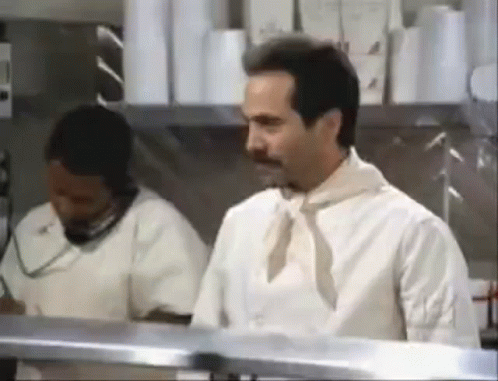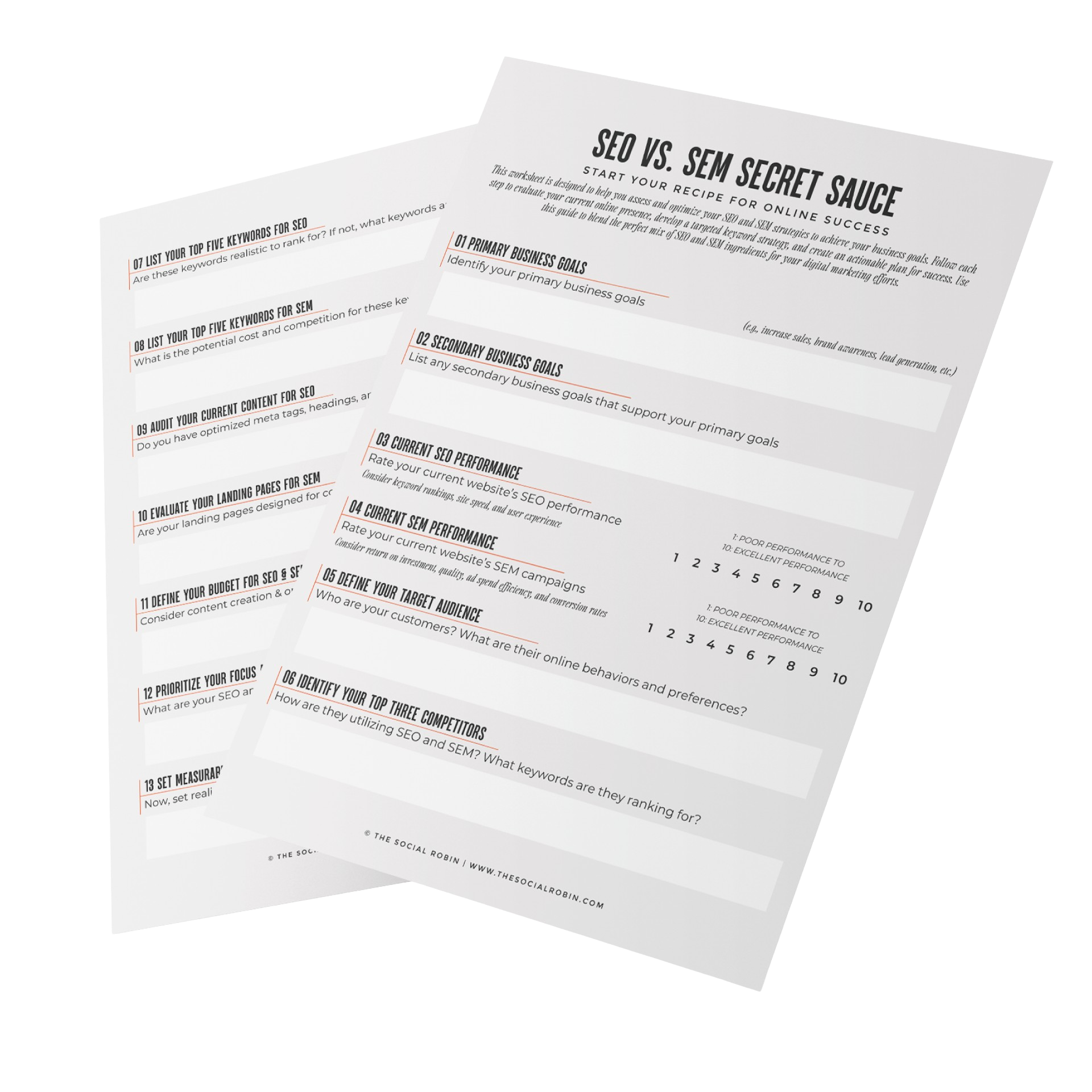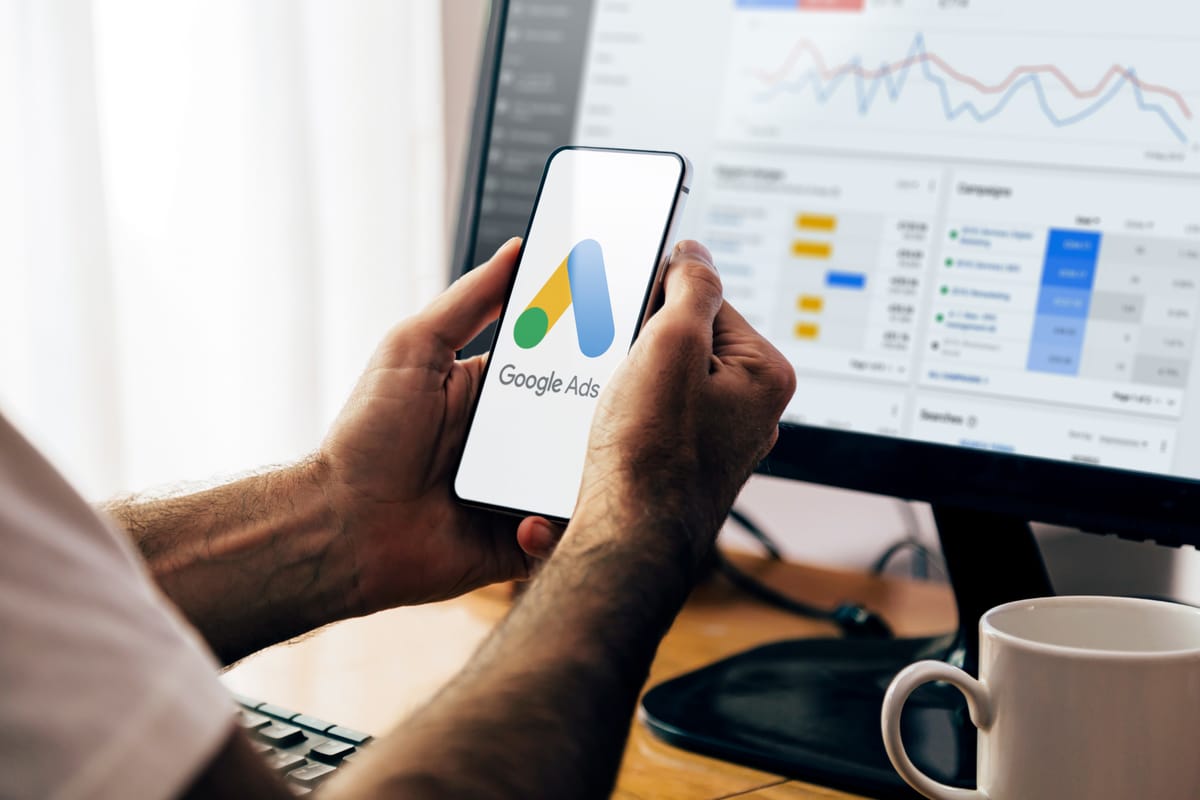Ah, to be on the first page of Google. Thousands of businesses are fighting it out for the same customers day after day, but there are a select few businesses that have just the right "secret sauce" to get to the first page and to get that sought-after click.
Was it SEO that won them that click? Or was it SEM? How do you know which one will make up your own secret sauce? Is it 3 parts guacamole? How much habanero? What if my clients like mild sauce? How did we start talking about salsa? 🌶️
A Dash of SEM Here... and I'll have What SEO's Having
When prospective customers search on Google, they often look for answers, products, or services that meet their immediate needs.
SEO (Search Engine Optimization) and SEM (Search Engine Marketing) are the two primary strategies businesses use to furiously climb the ranks of search results.
But what’s the difference between them, and how can you use both to win the never-ending battle to the first page?
Well, SEO is like slow-cooking a rich, flavorful sauce. It involves nurturing your website with the right elements over time to grow its visibility organically. That means you're not paying Google a dime. You're not paying-to-play.
On-page SEO focuses on optimizing your site's content and structure, while off-page SEO involves activities like link building to enhance your site’s reputation.
Local SEO ensures your business shows up in local searches, and technical SEO addresses the backend aspects like site speed and mobile optimization.
These are all different SEO strategies, and not all need to be done simultaneously—but they can and will produce fantastic results if so.
If you're unsure, ask the chef, ahem, a professional, for just the right blend. But I can assure you, you'll want what SEO's having.

Why? According to Markitors, SEO leads have a 14.6% close rate, while outbound leads (such as direct mail or print advertising) have a close rate of only 1.7%.
On the other hand, SEM is like using a high-quality blender to whip up a quick and spicy salsa. It involves paid strategies like Google Ads to drive traffic to your site.
It's much faster (months, not years). We know most of the ingredients. It's pay-to-play. You jump to the top for some $$, and the clicks come faster.
SEM includes bidding on keywords and creating compelling ad copy to attract clicks.
Alas, there's some caution with SEM's recipes...
When Your Keyword is an Ugly Carrot
Keywords are the essential ingredients in your digital cooking. For both SEO and SEM, keywords play a crucial role in ensuring your content appears when users search for relevant terms.
However, the approach to keywords differs between the two.
And that's why we look for the ugly carrots as creative copywriters who care.
For SEO, it’s about naturally incorporating keywords into your content, meta descriptions, and titles. It’s a long-term strategy that requires patience and consistency.
Imagine your website is a beautiful dish, and suddenly, for SEO and SEM sake, a keyword is thrown in haphazardly. It doesn't match the recipe and doesn't enhance the flavor.

In the digital world, stuffing your content with awkward, irrelevant keywords is like tossing ugly carrots into your gourmet meal. It disrupts the flow, confuses your audience, and can leave a bad taste in their mouths.
Keywords should align with your content strategy and make sense to your audience. They need to spark interest and provide value, like the perfect blend of spices that enhances your dish rather than overpowering it.
When keywords are used correctly, they seamlessly integrate into your content, enhancing its flavor without drawing unwanted attention. This is where the power of ad copy and creative writing comes into play.
The Power of Ad Copy and Creative Writing
Just like the right mix of spices can transform a dish, compelling ad copy and creative writing can elevate your SEO and SEM strategies.
It's the difference between seeing that ugly carrot I mentioned and seeing the latest post from your favorite food blogger – one entices you to dig in, while the other makes you question the dish.
Or think. What the heck is that doing in my pasta. Waiter!
Creative and engaging ad copy grabs attention, sparks curiosity, and drives action. It's about more than just stuffing keywords into your content; it's about telling a story that resonates with your audience and compels them to take the next step.
This is where the art of copywriting shines. By crafting messages that are not only optimized for search engines but also engaging for human readers, you create content that converts.
Google’s latest updates emphasize the importance of quality content. Your writing should not only be optimized for search engines but also resonate with human readers. It’s about creating content that captivates – content that’s informative, engaging, and persuasive.
Imagine your ad copy as the first bite of a delicious meal. It needs to grab attention, whet the appetite, and make the reader want more. Great ad copy, combined with strategic keyword use, can significantly enhance your SEM efforts.
The most compelling ad copy and strategic keywords can get you a Michelin star for SEM. (I don't think that exists, but if it did, I'm sure most would just prefer a $500 coupon for Google Ads.)
Bidding and Targeting in SEM
However, creating ad copy that gets a click and leads prospective customers to your website is only part of the SEM equation.
To truly maximize your SEM efforts, you need to master the art of bidding and targeting. Bidding and targeting are critical components of a successful SEM strategy.
Who is clicking? How much did I pay? Why is my money already gone by 10:00 a.m.?
You need to determine which keywords are worth bidding on and how much you’re willing to pay per click.
This requires constant monitoring and adjustment to maximize your return.
Effective targeting ensures your ads reach the right audience for your brand. You can refine your targeting based on demographics, location, and user behavior, ensuring your ads are seen by those most likely to convert.
While SEM can produce quick results, it generally takes about 3 to 6 months to see significant returns on your investment, provided your strategy is well-executed and consistently monitored.
Earlier, I mentioned a bit of caution about SEM. It can be expensive and requires a vigilant approach to manage costs and prevent overspending.
That high-quality blender for this secret sauce always needs informed adjustments and attention. And care.
Preventing Page Bounce...Where Did They Go?
A high bounce rate can be detrimental to both SEO and SEM efforts.
If users leave your page too quickly, it signals to search engines that your content may not be relevant. It's bad news.
This affects your organic ranking and can waste your ad spend. All of that hard work goes right out the window.
No soup for you.

To prevent bounce, the goal is to make sure that the pages that your prospective clients land on (landing pages) are relevant, engaging, and easy to navigate.
Provide clear calls to action and ensure your content meets the expectations set by your keywords and ads. Use creative copywriting to captivate.
That also means that your SEM keywords match the page they landed on.
For example - if your SEM ad describes an organic, caramelized carrot, fresh from Argentina in a limited release - the page should land on a page selling that long-awaited Argentinian beauty of a carrot.
Not a list of 14 products with the carrot product at the bottom of a page that takes the user 15 seconds to find it.
BOUNCE.

How Do You Budget?
Both SEO and SEM require investment, but the nature of that investment differs. SEO is a long-term strategy that involves consistent effort and optimization.
It’s like perfecting a family recipe – it requires time, patience, and ongoing care.
SEM, on the other hand, requires a more immediate financial commitment.
You pay for each click, and your budget can quickly deplete if not managed carefully. And you may also pay for the service it takes to manage SEM... and perfect that recipe.
However, the potential for quick results makes it a valuable tool, especially for time-sensitive campaigns.
When Both Dishes Look Delicious
While SEO and SEM are often seen as this or that, they are more like the perfect blend of ingredients in your marketing recipe.
SEO builds a solid foundation and sustainable growth, while SEM provides quick, targeted results. Together, they create a powerhouse that can drive substantial traffic and conversions.
You might use SEM to promote a new product launch and gain immediate visibility while your ongoing SEO efforts ensure your site remains relevant and authoritative in the long run. It's a perfect one-two punch.
However, it's important to note that you don't always need SEM. When implemented well, SEO can be all you need.
That's right. No dash of SEM required.
This typically follows a well-orchestrated SEO strategy tailored to your business.
Each company's SEO strategy is different and requires time to see significant results.
According to Forbes, you can mentally prepare for it to take at least a year to see substantial improvements from a well-implemented SEO strategy, though you will see some progress before the year mark.
Why? Always remember—your competitors are likely doing the exact same thing across the entire United States (at a minimum) at the same time. Every. Single. Day.
This is why SEO and SEM is a never-ending battle—or, perhaps, why we stay in the kitchen, perfecting our recipes day in and day out to battle it out with our competitors.
Then, describing new dishes to make our customers say undeniably, yes, that's exactly what I want and I want it from you.
Bring More Customers to your Front Door with Your Own SEO & SEM Secret Sauce.
By combining SEO's long-term benefits with SEM's immediate impact, you can create a powerful, holistic approach to digital marketing.
But which is best for a dedicated professional like you?
Let's roll up your sleeves, gather your ingredients, and find out.




Member discussion